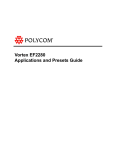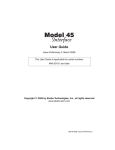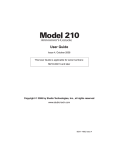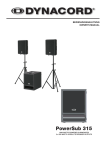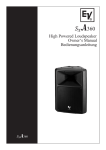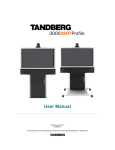Download ECHOFREE™ ACOUSTIC ECHO CANCELLER USER MANUAL
Transcript
ECHOFREE™ EF400 ACOUSTIC ECHO CANCELLER USER MANUAL Copyright © 1999 ASPI Digital. All rights reserved. Printed in the United States of America. Because of technical progress, specifications are subject to change without notice. EchoFree is a trademark and ASPI is a registered trademark of ASPI Digital. ASPI Digital - The Sound of DSP 1720 Peachtree Street NW, Suite 220 Atlanta, GA 30309-2439 (404) 892-3200 www.echofree.com Technical Support: (404) 892-3200 [email protected] EF400UM-0100-99 EF400 USER MANUAL Introduction..................................................................................................2 Product Features .................................................................................................... 3 Installation ....................................................................................................4 Preparing................................................................................................................ 4 EF400 Front and Rear Panels................................................................................ 5 Prepare the Room ................................................................................................... 6 Select a Mounting Location .................................................................................... 6 Connect Equipment................................................................................................. 6 Configuration ..............................................................................................8 Setting the Bandwidth Switch ................................................................................. 8 Setting the Run/Setup Switch .................................................................................. 8 Setting the Phantom Power Switch......................................................................... 8 Calibration....................................................................................................9 Overview ................................................................................................................. 9 About Signal Levels ................................................................................................ 9 Calibration Steps .................................................................................................... 11 Calibration Verification ......................................................................................... 16 Operation ......................................................................................................17 Training .................................................................................................................. 17 The Mute Button ..................................................................................................... 17 Record and Playback.............................................................................................. 17 General Conferencing Guidelines ......................................................................... 18 Troubleshooting ...........................................................................................19 No Output to Loudspeakers (you can’t hear them) ................................................ 19 No Output to Remote End (they can’t hear you) .................................................... 19 Residual Echo ......................................................................................................... 20 Technical Support................................................................................................... 22 Technical Specifications ..............................................................................23 Warranty Information ................................................................................25 Appendix: About AEC ................................................................................27 ASPI Digital, Copyright 1999 1 EF400 USER MANUAL INTRODUCTION Congratulations! Congratulations on your purchase of the EchoFree™ EF400 Acoustic Echo Canceller (AEC). By choosing the EF400, you have gained an exceptional communications system that delivers crisp, clear audio and efficient, comfortable conferencing. About the EF400 User Manual This manual tells you how to install, configure, and calibrate the EF400 to function in a hands-free conferencing system. It also provides information about operating and troubleshooting the EF400. Product Description The EchoFree™ EF400 AEC supports two-way conversations in hands-free communications applications. The EF400 eliminates echoes and acoustic feedback that occur when loudspeaker audio is picked up by room microphones. Whether you are using the EF400 in a small cubicle or a large conference room, all parties can communicate simultaneously without echoes, switching noises, clipping of words, or dropout of speech. A patented state-logic algorithm ensures smooth and natural communications without typical speakerphone performance problems. The EF400 employs a subband digital filtering architecture for echo cancellation. This architecture provides faster convergence and better performance than other echo cancellers. It continually adapts to changes in the environment so that participants can move about freely and volume levels may change during the conversation without adversely affecting communication quality. Unlike most other echo cancellers, the EF400 requires no training sequence to learn a room’s echo response. This means there are no annoying tone bursts at the beginning of the conversation. After the unit has been installed, all you have to do is turn it on. No further adjustments are required. You can move the speaker or microphone or change rooms without putting the EF400 through a training sequence. This is possible because of the EF400’s advanced acoustic echo cancellation technology. And it means the EF400 adapts to changes in room acoustics during conversations quickly for consistent performance throughout the conversation. In addition to superior echo cancellation, the EF400 provides high-fidelity audio connections. This allows low-noise, trouble-free interaction with professional or consumer quality audio equipment. Warranty Registration 2 Please take a moment to fill out and return your warranty registration card. This information will help us to provide you with better customer support. Copyright © 1999, All Rights Reserved INTRODUCTION PRODUCT FEATURES • • • • • • • • • • • • • • • • • • • ASPI Digital - The Sound of DSP Full-duplex communications that sounds real and natural with no switching, dropouts, or speech clipping. All parties can be heard simultaneously. Based on proven, patented technology. Automatic training does not require noise bursts or tones for setup. Continuous and quick adaptation to changes in room acoustics with a 30dB/s convergence rate. Howling rejection (feedback suppression). Long tail time (200 ms) for even difficult rooms. Operates with up to 10dB room gain. Supports 3.5kHz and 7kHz speech and audio communications (switch selectable). Supports muting without disabling AEC adaptation. Balanced, professional line-level input and output permit direct connection to CODECs and other professional quality equipment. Connects to the EF200 Phone Add to make a complete teleconferencing unit. Accepts mic-level input (switch selectable). Unbalanced record input and playback output for connecting external equipment. Small footprint fits easily in rollabout carts or on rack tray. Easy set up. After input and output levels are calibrated, operation is completely automatic. Tamper proof. No external level controls for unauthorized users to disturb. Continuous and quick adaptation to new environments. Does not require memory to store room settings. Guaranteed superior workmanship backed by a full two-year warranty. Extended warranty available. 3 EF400 USER MANUAL INSTALLATION PREPARING The EF400 product package includes the following items: • • • • • EF400 User Manual (this manual) EF400 Acoustic Echo Canceller External power supply Warranty registration card Flat head trimpot adjuster. You need the following tools to install and configure the EF400: 2 4 -10 SOUND LEVEL METER +6 4 BATT dB 2 RESPONSE SCREWDRIVER RANGE > 70 0 SLOW FAST OFF A C • EF400 User Manual (this manual) Small Phillips head screwdriver for opening the top of the EF400 Hand-held SPL meter for measuring loudness (such as the Radio Shack 33-2050 Sound Level Meter) Small plastic trimpot adjuster for adjusting the electrical signal levels (included). WEIGHTING • • • You need the following additional equipment to create a completely functional system: • • • • • • • • 4 Microphone(s) Speaker(s) Audio amplifier (or amplified speaker) CODEC and/or EF200 Phone Add Audio cables Tape recorder or VCR (optional) Mute switch (optional) RS200 Rack Mount shelf (optional). Copyright © 1999, All Rights Reserved INSTALLATION EF400 FRONT AND REAR PANELS T H E POWER MICROPHONE REMOTE MUTE 1 2 3 4 SPEAKER OUTPUT INPUT O F D S P EchoFree EF400 TM 13 MIC INPUT S O U N D 14 OUTPUT + 5, + / - 1 5 1(875,. 2 PLAY RECORD MUTE ROOM INPUT VDC 11 12 1 3 ROOM 5 REMOTE 6 7 TAPE 8 9 10 Figure 1. The front and rear panel of the EchoFree EF400. 1. 2. 14. POWER INDICATOR. When LED is green, power is on. MICROPHONE INPUT LEVEL INDICATOR. Displays microphone input signal level. See page 12. REMOTE INPUT LEVEL INDICATOR. Displays remote input signal level. See page 13. MUTE INDICATOR. When the LED is blue, local audio is not sent to the remote connection. MIC INPUT. Connects to a mic, mic preamplifier, or mixer. Provides phantom power to condenser microphones. Configured via the internal phantom power switch. See page 8. SPEAKER OUTPUT. Connects to an audio amplifier or powered speaker. (Line level output cannot drive a speaker without an amplifier.) REMOTE INPUT. Connects to the output of a CODEC or EF200 Phone Add. REMOTE OUTPUT. Connects to the input of a CODEC or EF200 Phone Add. TAPE PLAYBACK INPUT. Connects to the output of a tape recorder, VCR, or other recording device. This signal is sent to the remote output as well as the speaker output. See Figure 5 on page 17. TAPE RECORD OUTPUT. Connects to a recording device. Signals from the remote and mic inputs (both ends of the conversation) go to the recording device. See Figure 5 on page 17. MUTE ROOM INPUT. Connects to the mute switch (not included but an example circuit is shown in Figure 4 on page 17). The mute switch turns off the REMOTE OUTPUT while still allowing adaptation. It prevents local conversations from being sent to the remote site. POWER SUPPLY INPUT. Connects to the external power supply. CHASSIS LID SCREW. Loosen this screw to lower the LOCK BAR, open the chassis, and make adjustments to the EF400. LOCK BAR. Latches on to the CHASSIS LID SCREW to keep the lid on. ASPI Digital - The Sound of DSP 5 3. 4. 5. 6. 7. 8. 9. 10. 11. 12. 13. EF400 USER MANUAL PREPARE THE ROOM To ensure good acoustics in the room, add carpeting, curtains, or acoustic tiles to the conferencing room. Improving room acoustics enhances the performance of the EF400 and the sound quality and intelligibility of local speech. Keeping microphones near people and away from loudspeakers and noise sources (fans, air vents, and projectors for example) also improves the performance of the EF400. SELECT A MOUNTING LOCATION After verifying that you have all the equipment and material required for the installation, select a mounting location for the system. You can mount the EF400 on a table top or an ASPI Digital RS200 Shelf. The RS200 Shelf can support two EF400s mounted side-by-side, or an EF400 and an EF200 Phone Add for using the EF400 with a telephone line. Assemble your tools and all required and optional equipment in an area that is convenient to the mounting location. microphone CONNECT EQUIPMENT CODEC/hybrid M ICROPHONE I NPUT S PEAKER O UTPUT TX I NPUT O UTPUT 1(875,. 2 RX P LAY R ECORD 1 M UTE R OOM I NPUT +5,+/-15 VDC 3 R OOM R EMOTE T APE auto-reverse TAPE RECORDER VCR POWER LOW HIGH VOLUME MIC POWERED SPEAKER Figure 2. Connection of typical external equipment to the EF400. Required Connections Certain equipment and connections are required for the EF400 to be fully operational. (Figure 2 depicts typical connections.) Complete the following steps to make all the required connections: 1. 2. 3. 4. 6 Connect the MIC INPUT to a microphone or to the output of a microphone preamplifier. The MIC INPUT accepts balanced XLR-type or balanced Phone (TRS) connectors. Connect the SPEAKER OUTPUT to the input of an audio amplifier or powered speaker. This output cannot drive an unamplified speaker. The SPEAKER OUTPUT accepts a balanced XLR-type connector. Connect the REMOTE INPUT to the output of your terminal equipment, usually a CODEC, or the FROM AEC connection on the EF200 Phone Add. The REMOTE INPUT accepts a balanced XLR-type connector. Connect the REMOTE OUTPUT to the input of your terminal equipment, usually a Copyright © 1999, All Rights Reserved INSTALLATION CODEC, or the TO AEC connection on the EF200 Phone Add. The R EMOTE OUTPUT accepts a balanced XLR-type connector. Important! Verify that the EF400 REMOTE INPUT is connected to the output of the CODEC and the EF400 REMOTE O UTPUT is connected to the input of the CODEC. 5. Optional Connections You may find these connections useful, but they are not required for proper operation of the EF400. • • • Important! Connect the power supply connector to the external power supply included with the EF400. Record. To record with a tape recorder or VCR, connect the TAPE RECORD O UTPUT on the EF400 to the audio input on the recording device. This is an unbalanced RCA connector. Playback. To play back through a tape recorder or VCR, connect the TAPE PLAYBACK INPUT on the EF400 to the audio output on the playback device. This is an unbalanced RCA connector. Mute. To add mute capability, connect the MUTE ROOM INPUT on the EF400 to a mute button or other switching circuit. This is a two-conductor mini connector. If the switch is closed (that is, the two conductors of the MUTE ROOM INPUT are shorted), the REMOTE OUTPUT is muted. If the switch is open, the REMOTE OUTPUT is not muted. If you do not connect the mute button to the M UTE ROOM INPUT, the EF400 is not capable of muting audio. You can build a mute button using the schematic in Figure 4 on page 17. ASPI Digital - The Sound of DSP 7 EF400 USER MANUAL CONFIGURATION You must configure several options using the DIP switch S7. These options are described below. Refer to the EF400 Circuit Board Layout on page 12 for the location of DIP switch S7. (You must open the EF400 chassis to access the DIP switches.) NOTE The side of the switch that is down is the side that is selected. For instance, if the 7.0kHz/3.5kHz switch is down on the 7.0kHz side, the EF400 is operating in 7.0 kHz mode. The switches rock up and down rather than sliding from side to side. Important! Switches 1 through 3 are reserved. Keep them in the factory default positions. The factory default positions are ON (1), OFF (2), and OFF (3). A switch is off if the left side is pressed down. SETTING THE BANDWIDTH SWITCH Keep this switch in the 7kHz position for most applications. Wide Bandwidth If you use a wide bandwidth (7kHz) CODEC, set the bandwidth switch to the 7kHz position. If you connect to wideband and narrowband connections (that is, if your system connects to a wideband video CODEC or a narrowband telephone connection through the EF200 for different calls), set the bandwidth switch to 7kHz. Narrow Bandwidth If you connect only to narrowband terminals, set the bandwidth switch to the 3.5kHz position. In extreme conditions, you may find that the EF400 works better in the 3.5 kHz mode. SETTING THE RUN/SETUP SWITCH Whenever you calibrate the EF400, set the RUN/SETUP switch to SETUP position. During normal operation, set the RUN/SETUP switch to the RUN position. Setup mode is active only if the EF400 is reset when the RUN/SETUP switch is in the SETUP position. The EF400 may be reset by changing the bandwidth switch back and forth. Setup mode is exited and normal operation restored when the RUN/SETUP switch is set to RUN. SETTING THE PHANTOM POWER SWITCH Condenser and electret microphones need phantom power. Dynamic microphones do not. Phantom power may damage a dynamic microphone. If you are not sure whether the microphone needs phantom power, check the microphone specifications. Power Required If a microphone is connected to the MIC INPUT and the microphone requires phantom power, set the PHANTOM POWER switch to PHANTOM. Power Not Required If a microphone preamplifier or a microphone is connected to the MIC INPUT and neither device requires phantom power, set the PHANTOM POWER switch to OFF. 8 Copyright © 1999, All Rights Reserved CALIBRATION CALIBRATION OVERVIEW For the EF400 to work effectively, you must calibrate the input and output signal levels correctly. Calibration is required to relate a loudness value (as measured by a sound-level meter) to the electrical signal associated with the loudness. Note The calibration procedure is required only to adjust the EF400 to accommodate the electrical characteristics of your conferencing equipment. The procedure permits you to connect the widest possible variety of equipment to the EF400. The calibration procedure does not train the AEC. The EF400 does not require training. In calibration mode, the EF400 generates a precise noise signal for measuring the characteristics and sensitivity of the microphone. You only need to perform this calibration at the initial installation. You do not have to calibrate the EF400 each time it is used. When calibrated for the particular microphone and CODEC setup, the EF400 will provide years of service without recalibration. If the signal levels are not calibrated, the performance of the EF400 may not be satisfactory. When the signal levels are calibrated correctly, the EF400 easily and automatically handles any type of signals and change in room acoustics for unparalleled echo cancellation performance. Important! After calibration, the microphone input signal and remote input signal must be at the same nominal signal level. If these two inputs differ in nominal level by 6dB or more, the performance of the EF400 will be compromised. ABOUT SIGNAL LEVELS Audio signal levels for the EF400 inputs and outputs are controlled by trimpots, which you can see by sliding back the unit’s top cover. These trimpots are lined up with the appropriate backpanel connector and are labeled (viewed from the front and left to right) RECORD, PLAYBACK, REMOTE OUTPUT, REMOTE INPUT, SPEAKER OUTPUT, MIC INPUT, and MIC GAIN . A plastic trimpot adjuster is shipped with the EF400 to allow the levels to be adjusted. The EF400 works with audio equipment requiring signal levels in the range of +4dBu to -20dBu. This range covers professional-audio levels (+4dBu) and consumer-equipment levels (-8dBu or -10dBV). It also allows a further 12dB signal attenuation to 20dBu if required. The most commonly used levels (+4, -8, and -20dBu) are labeled on the trimpots for MIC INPUT, SPEAKER OUTPUT, REMOTE INPUT, and REMOTE O UTPUT. Refer to Figure 3 on page 10 for additional information. Important! The markings on output trimpots refer to the level that is output on the corresponding connector. To increase the level of the room or remote output, turn the trimpots clockwise towards +4dBu. Important! The markings on the input trimpots correspond to the levels expected to be input to the EF400. If the R EMOTE INPUT signal is too low, to boost the signal turn the trimpot adjuster clockwise towards -20dBu. Note that both input and output trimpots must be turned clockwise to boost the input and output signals, but the text around the output trimpots is in reverse order to the text around the input trimpots. ASPI Digital - The Sound of DSP 9 EF400 USER MANUAL MIC GAIN LINE S9 MIC RECORD -8 -8 R33 -6 -4 R17 -12 PLAYBACK -20 REMOTE OUTPUT -8 R25 -20 +4 REMOTE INPUT -8 R24 +4 SPEAKER OUTPUT -8 R5 -20 -20 +4 -8 R5 MIC INPUT +4 -20 SINGLE-TURN POTS. TURN CAREFULLY. DO NOT EXCEED TURNING ARC. ! Caution ! U S E STATIC SENSITIVE P R E C A U T I O N S! S7 1 2 3 RUN 7.0 kHz OFF SETUP 3.5 kHz PHANTOM EchoFreeT M EF400 A quality product made in the USA Figure 3. EF400 Circuit Board Layout 10 Caution! Do not damage the EF400’s circuitry. Use the plastic static-safe trimpot adjuster shipped with the unit for all adjustments. Do not use a metal screwdriver or allow jewelry, chains, or pendants to contact the EF400 enclosure. Metal tools and objects may cause a short circuit, damage the circuit board, and void your warranty. Caution! When using the supplied trimpot adjuster to adjust signal levels, do not touch any other components on the EF400 circuit board with the trimpot adjuster. Copyright © 1999, All Rights Reserved CALIBRATION CALIBRATION STEPS Step 1—Prepare the EF400 Follow the steps listed here to prepare the EF400 for calibration of the signal levels. SCREWDRIVER 1. 2. Power down the EF400. If you have not already done so, connect the microphone (or mixer) to the MIC INPUT and the room speaker amplifier (or powered speaker) to the SPEAKER O UT- 3. If you have not already done so, connect the terminal equipment to the R EMOTE INPUT and REMOTE O UTPUT as shown in Figure 2. Turn the volume of the amplifier/powered speaker down to zero. Loosen the C HASSIS LID SCREW in the upper middle of the backpanel, and slide the LOCK BAR down. Slide the top cover back to expose the line of trimpots. These trimpots are lined up with the appropriate backpanel connector and are labeled. (Refer to Figure 3 on page 10.) Identify the DIP switch S7 in the center left of the EF400. Set the RUN/SETUP switch to the SETUP position. This generates a white noise signal on the SPEAKER OUTPUT (which is used to set the microphone input level) when the system is powered up. PUT 4. 5. 6. 7. Important! Step 2—Calibrate Speaker Output Now you are ready to calibrate the EF400 signal levels. Do not apply power to the EF400 until directed to do so in the following instructions. You must match the speaker output level to the specified nominal input level of your powered speaker or amplifier. 1. 2. ASPI Digital - The Sound of DSP Determine the appropriate nominal signal level for your powered speaker or loudspeaker amplifier. The specifications for your powered speaker or amplifier should include the nominal input signal level. If you do not have nominal level specifications for your loudspeaker/amplifier, or if the specifications are unclear, use these guidelines. If you are using a powered speaker, it probably requires a 8dBu input level. If you are using an amplifier and the connectors are RCA phono connectors, use -8dBu. If the connectors are balanced (most likely XLRtype connectors), use 0dBu (this is half way between the +4 and -8 marks around the SPEAKER OUTPUT trimpot). Turn the SPEAKER OUTPUT trimpot until the trimpot slot points to the marking on the EF400 circuit board corresponding to the nominal level selected in the previous step. If the input signal level for your powered speaker or amplifier are specified in terms of dBu or dBm, this number corresponds to the numbers (+4, 0, -8, -20) printed on the EF400 circuit board. If the speaker or amplifier level is 11 EF400 USER MANUAL specified in terms of dBV, add 2 to the dBV number to translate it to dBu (for example.–10dBV corresponds roughly to -8 dBu). After the SPEAKER O UTPUT is calibrated, you can calibrate the MIC INPUT level. 2 4 -10 SOUND LEVEL METER +6 4 BATT dB 2 RESPONSE RANGE > 70 0 SLOW FAST OFF A C In this step, you calibrate the mic input level using a 73dB SPL noise signal (generated by the EF400). You want to illuminate the first yellow LED but not the second yellow LED on the front panel MICROPHONE INPUT LEVEL INDICATOR. WEIGHTING Step 3—Calibrate Microphone Input You use the built-in noise generator and your SPL meter to set the mic input level . Important! Note Extraneous noise (such as conversation) should not be audible in the local conference room, as it would make it very difficult to get consistent readings on the SPL meter and MICROPHONE INPUT LEVEL INDICATOR. You use different trimpots to calibrate the MIC INPUT level , depending on whether the input signal is line level (from a microphone preamplifier) or mic level (directly from a microphone). 1. • • Note If the MIC/LINE switch is in the LINE position, you will be adjusting the MIC INPUT trimpot to a range between -20dBu and +4dBu input signal level. If the M IC/LINE switch is in the MIC position, you will be adjusting the MIC GAIN trimpot to a range between +15dB and + 60dB gain. (This level accommodates microphone signal levels between -33dBu and -80dBu.) 2. • • 3. 4. 12 Locate the MIC/LINE switch S9, the MIC INPUT trimpot, and the MIC GAIN trimpot. (They are to your right and near the back of the circuit board in line with the MIC INPUT connector). If you are using a microphone mixer or preamplifier, set the M IC/LINE switch to the LINE position. If you are connecting a microphone directly to the EF400, set the MIC/LINE switch to the MIC position. Turn the appropriate trimpot to its minimum setting. If the MIC/LINE switch is in the LINE position, you will use the MIC INPUT trimpot for input level adjustment. Turn the MIC INPUT trimpot fully counterclockwise (to the +4 position). If the MIC/LINE switch is in the MIC position, you will use the MIC GAIN trimpot for input level adjustment. Turn the MIC GAIN trimpot counterclockwise several times (this is a multi-turn pot). Position the room microphone so that no people or objects are between it and the loudspeaker. Be careful not to stand directly between the loudspeaker and the microphone while adjusting the EF400. The microphone should be approximately 1m from the loudspeaker (if possible), and the loudspeaker and the microphone should be pointing towards each other. Set the range on the SPL meter to 70dB, C weighted, fast response. Place the SPL Copyright © 1999, All Rights Reserved CALIBRATION 5. 6. • • Note If adjustment of the trimpot appears to have no effect on the MICROPHONE INPUT LEVEL INDICATOR, return to Step 1 and verify that you are adjusting the correct trimpot. 7. 8. Important! Step 4—Calibrate Remote Input Important! meter beside the microphone. Point the SPL meter toward the loudspeaker. Turn on the EF400 (you will hear white noise on the loudspeaker), and adjust the volume on the loudspeaker until the SPL meter reads 73dB. Stand to the side of the SPL meter (rather than in front of it or behind it) while reading it, so that your body does not interfere with the reading. Adjust the appropriate trimpot and observe the LEDs on the front panel MICROPHONE INPUT LEVEL INDICATOR. If the MIC/LINE switch is in the LINE position, turn the MIC INPUT trimpot clockwise. If the MIC/LINE switch is in the MIC position, turn the MIC GAIN trimpot clockwise. You may need to turn this pot several times. Continue to adjust the trimpot until all three green LEDs and only the first yellow LED are illuminated. The second yellow LED should not be illuminated (it may flicker occasionally). Move your loudspeaker and microphone back to their normal operating positions. Set the RUN/SETUP switch back to the RUN position. The EF400 is now in normal operating mode. Avoid pointing the microphone directly at the speaker when in normal operating mode. This alignment reduces the maximum acoustic gain allowed in your conferencing setup. This step matches the remote input level to the microphone input level by matching the level on the REMOTE INPUT LEVEL INDICATOR to the level on the MICROPHONE INPUT LEVEL INDICATOR. If the EF400 is connected to an EF200 Phone Add, turn the REMOTE INPUT trimpot to -20 dBu (fully clockwise). During this step, you must be able to converse with someone at the remote end of the communications link. It is also important to eliminate extraneous noise (such as other people speaking) at both ends of the communications link, as such noise would interfere with MICROPHONE INPUT LEVEL INDICATOR and REMOTE INPUT LEVEL INDICATOR readings. 1. 2. 3. ASPI Digital - The Sound of DSP Position yourself so that you can easily see the EF400 front panel signal level indicators and reach the REMOTE INPUT trimpot. Now move the local room microphone so that it is facing you at a normal speaking distance (usually 1–1.5 meters) when you are in this position. Instruct the person at the remote end to sit at a normal distance from the remote microphone (usually 1–1.5 meters). Have this person read something to you, using a normal speaking voice. While the person at the remote end is talking, adjust the REMOTE INPUT trimpot until normal conversation level consistently illuminates the three green LEDs and only the first yellow LED on the REMOTE INPUT LEVEL INDICATOR. Louder 13 EF400 USER MANUAL 4. Note If the person at the remote end cannot hear you clearly when you speak at a normal level, turn the REMOTE OUTPUT trimpot clockwise (towards +4dBu). Continue the clockwise adjustment (up to +4dBu) until they can hear you clearly. 5. 6. Step 5—Calibrate Remote Output speech will cause the second yellow LED to pulse on and off.. The level on the indicator will vary as the speech energy from the remote end varies; the indicator indicates peak energy in a similar fashion to a VU meter. Now speak in a normal voice with the person at the remote end. You should still be positioned as described in Step 1, facing the microphone at distance of 1–1.5 meters. Observe the MICROPHONE INPUT LEVEL INDICATOR and REMOTE INPUT LEVEL INDICATOR. Both indicators should show similar levels of activity in reaction to passages of similar speech strength. If the REMOTE INPUT LEVEL INDICATOR consistently illuminates more LEDs than the MICROPHONE INPUT LEVEL INDICATOR, turn the REMOTE INPUT trimpot counterclockwise (towards +4dBu) to compensate. If the REMOTE INPUT LEVEL INDICATOR consistently illuminates fewer LEDs than the MICROPHONE INPUT LEVEL INDICATOR, turn the REMOTE INPUT trimpot clockwise (towards -20 dBu) to compensate. If you moved your microphone in Step 1, now move it back to its normal operating position. This step shows you how to match the remote output level to the remote input level by adjusting the REMOTE OUTPUT trimpot. If you are using the EF400 with an EF200 Phone Add, turn the REMOTE OUTPUT trimpot to -20 dBu (fully counterclockwise). Set the REMOTE OUTPUT trimpot to the same numeric level as you previously selected for the REMOTE INPUT level. Turn the REMOTE OUTPUT trimpot until the trimpot slot points to the marks on the EF400 circuit board that correspond to the level you selected on the REMOTE INPUT trimpot. Important! Note Step 6—Tape Playback and Record Levels 14 Remember that the numeric markings around the REMOTE OUTPUT trimpot are in reverse order to those around the REMOTE INPUT trimpot. The input and output audio levels at the remote equipment may not be symmetric because of imbalances in the remote equipment or the interposing communications equipment. You can compensate for such imbalances by adjusting the REMOTE OUTPUT level. If the audio signal at the remote end is overdriven and distorted after you set the REMOTE OUTPUT level, adjust the REMOTE OUTPUT trimpot down (counterclockwise). If the audio signal at the remote end is too low, adjust the REMOTE OUTPUT trimpot up (clockwise). The tape playback and record levels should not require adjustment. Copyright © 1999, All Rights Reserved CALIBRATION The TAPE PLAY INPUT and TAPE RECORD OUTPUT interface to consumer grade audio equipment such as a tape recorder or VCR. These connectors are designed for -8dBu nominal signal level. Set the trimpots for these connections to -8dBu for most applications. If these levels prove unsatisfactory for any reason, adjust them up or down by several dB. Step 7—Install EF400 AEC Unit Slide the top cover forward on the EF400 and secure it with the lock bar and chassis lid screw. The EF400 is now ready for tabletop or rackmount installation. SCREWDRIVER Tabletop Installation The EF400 is equipped with four rubber feet that allow installation on a flat surface such as a tabletop. 1. 2. Remove the adhesive backing on the rubber feet. Install the rubber feet in the circular cutouts on the EF400 baseplate. Rackmount Installation 1. 2. 3. 4. 5. After you complete the configuration and calibration procedures, place the EF400 on the ASPI Digital RS200 Shelf. Secure the EF400 to the RS200 shelf using four of the small screws (4-40 x ¼") provided with the RS200. If one EF400 is to be mounted on the shelf, place it in the center. If two units are to be mounted, mount them size by side. If only one EF400 is mounted, attach the two small faceplates supplied with the RS200 to each side of the EF400. Use four more of the small screws to secure the face plates. Secure the RS200 shelf to the rack using all four large screws (10-32 x ½") supplied with the RS200. The EF400 power supply block should be placed securely in the base of the rack unit. To eliminate any risk of the power cable being pulled out of the EF400 rear panel connector, use the plastic Ty-Wraps provided with the RS200 to provide strain relief by securing the power cable to the rack upright at the rear of the EF400. Caution! Failure to use all four screws to attach the RS200 shelf to the rack may result in uneven loading and cause a safety hazard. Caution! Ensure that the power supply is securely located such that it cannot become dislodged and fall. Such a fall could cause personal injury or equipment failure. Caution! When mounting an EF400 in a rack, consideration should be given to airflow and operating ambient temperatures inside the rack. To ensure safe operation of the EF400, ambient operating temperatures inside the rack should not exceed 50 degrees Celsius. Allow 2 inches of open space in front of the EF400, and four inches behind the unit for proper ventilation. Equipment should not be installed in the rack in such a way as to interfere with ventilation to the EF400. ASPI Digital - The Sound of DSP 15 EF400 USER MANUAL Caution! Consideration should be given to the connection of the equipment to the supply circuit and the effect that overloading of circuits could have on overcurrent protection and supply wiring. Appropriate consideration of equipment nameplate ratings should be used when addressing this concern. Caution! Reliable earthing of rack-mounted equipment should be maintained. Particular attention should be given to supply connections other than direct connection to the Branch (use of power strips). CALIBRATION VERIFICATION During normal operation (a conference), observe the front panel M ICROPHONE INPUT LEVEL INDICATOR and REMOTE INPUT LEVEL INDICATOR. The red LED should not flicker or illuminate on either meter. If either red LED illuminates or flickers frequently, reduce the corresponding input level. Both signal-level meters should exhibit similar behavior. The calibration process accommodates a nominal speech level at the room microphone (normal speech at 1m to 2m from the microphone). During low-level speech, several green LEDs may illuminate. During normal speech in a conference, the first yellow LED should illuminate frequently, and the second yellow LED should flicker regularly during periods of louder speech. Extreme and unusual levels (for example, a participant shouting into the microphone) may overdrive the input level and cause the red LED to illuminate. This is not cause for concern unless you expect this condition to be the normal operating mode! Similar speech activity levels at the local and remote ends should cause the same number of LEDs to illuminate on both signal strength meters. If the REMOTE INPUT LEVEL INDICATOR is consistently lower than the MICROPHONE INPUT LEVEL INDICATOR, adjust the REMOTE INPUT trimpot clockwise (toward the -20dBu mark) to bring up the level on the REMOTE INPUT LEVEL INDICATOR. If the REMOTE INPUT LEVEL INDICATOR is consistently higher than the MICROPHONE INPUT LEVEL INDICATOR, adjust the REMOTE INPUT trimpot counterclockwise (toward the +4 mark) to bring down the level on the REMOTE INPUT LEVEL INDICATOR. The remote equipment may be set up using a different procedure, and may be producing signals at a different level than the nominal input level of your terminal equipment. This would cause your terminal equipment to produce signals lower than its nominal level. Thus, the setting of the REMOTE INPUT trimpot may differ from the output signal level specifications for your terminal equipment. For example, your terminal equipment may specify a nominal output level of -8dBu, but you may have to set the REMOTE INPUT trimpot to -20dBu to bring the remote signal to the same level as the local microphone. 16 Copyright © 1999, All Rights Reserved OPERATION OPERATION The EF400 operates automatically. User interaction is not required unless the optional mute button has been installed. Below are instructions for using the EF400 and ensuring a successful conference. TRAINING Because of the EF400’s superior AEC technology, no training sequence is necessary. After the EF400 is powered up, it automatically adapts to the room’s acoustics. THE MUTE BUTTON When pressed, the mute button prevents local speech from being transmitted to the REMOTE OUTPUT and the TAPE RECORD output. The EF400 continues to adapt even though its output is muted. The mute signal can be provided by any normally open contact. The contact can be a switch on a microphone or control panel or provided by a relay-closure output on another piece of equipment. a) Unmuted b) Muted Figure 4. Schematic of mute button. If the switch is open (a), the EF400 is not muted. If the switch is closed (b), the REMOTE OUTPUT and TAPE RECORD are muted. Note If you mute the EF400 externally (such as with the P RIVACY feature on the EF200), the TAPE RECORD output will not be muted. RECORD AND PLAYBACK If you have a tape recorder connected to the EF400’s TAPE RECORD and TAPE PLAYBACK jacks, you can record conferences or play back material to parties on the both ends. When you record, both ends of the conversation are recorded on the tape. When you play a tape, the audio is sent to the remote end as well as the local end. If you have a standard tape deck, simply press play or record to play back audio or record a conference. The figure below shows how the record and playback signals are routed. Speaker Output Microphone Input Remote Input AEC Record Remote Output Playback Figure 5. Record and playback signal paths. ASPI Digital - The Sound of DSP 17 EF400 USER MANUAL GENERAL CONFERENCING GUIDELINES The EF400 adapts exceptionally well to changes in room acoustics, but audio quality will be even better when conference participants follow these guidelines: 1. 2. 3. 18 Sit or stand in one place and near a microphone. Moving around the room and toward or away from the microphone while talking may cause speech audio to fade in and out. Speak clearly and directly toward the microphone. Keep the microphone away from noise sources such as computer fans, air ducts, or coffee makers. Excessive noise can be annoying to people on the remote end and reduce intelligibility. It can also hamper the adaptation logic and degrade EF400 performance. Copyright © 1999, All Rights Reserved TROUBLESHOOTING TROUBLESHOOTING NO OUTPUT TO LOUDSPEAKERS (YOU CAN’T HEAR THEM) Check the REMOTE input level indicator. If the LED bar graph meter shows activity, the EF400 is receiving a signal. In this case, the problem is between the EF400 and the speaker. If there is no activity on the REMOTE input level indicator, the EF400 is not receiving a signal. In this case, the problem is between the EF400 and the microphone on the remote end. Check the CODEC (or EF200) output by connecting it directly to the amplifier or powered speaker. If you hear nothing, the EF400 is not causing the problem and the source of the problem is elsewhere in the system. Make sure the CODEC or EF200 output is connected to the REMOTE INPUT. Make sure the CODEC or EF200 is turned on and a call is established. Make sure everything on the remote end is working properly. Make sure the cables are not broken. Check the cable pinouts. Make sure the SPEAKER OUTPUT is connected to the amplifier (or powered speaker) input. Make sure the amplifier or powered speaker is on and that the volume is at an appropriate level. NO OUTPUT TO REMOTE END (THEY CAN’T HEAR YOU) Check the MICROPHONE INPUT LEVEL INDICATOR, and make sure it displays activity when you speak into the microphone. If LEDs show activity when you speak into the microphone, the EF400 is receiving the microphone signal. This means the remote end is not receiving a signal from the EF400. Check the REMOTE OUTPUT by connecting it to the amplifier or powered speaker (turn the speaker down to avoid howling). If the speaker emits sound when you speak into the microphone, the signal is making it through the EF400. This means there is a problem with the CODEC, the CODEC connection, or a device on the remote end. If the MICROPHONE INPUT LEVEL INDICATOR does not display activity, the EF400 is not receiving the microphone signal. This means there is a problem with the microphone or preamplifier. If there is no speaker output, unplug the mute button. If this fixes the problem, the mute button is damaged or incompatible with the EF400. If you are not using a microphone mixer and the microphone requires phantom power, make sure it is enabled in the EF400. Make sure the phantom power voltage is compatible with the microphone. Make sure the R EMOTE OUTPUT is connected to the CODEC or EF200 input. Make sure the CODEC or EF200 is turned on. Make sure everything on the remote end is working properly. Make sure the cables are not broken. Check the cable pinouts. ASPI Digital - The Sound of DSP 19 EF400 USER MANUAL Make sure the microphone mixer (if present) is on and that the volume is up. Make sure the microphone is plugged into it. If the microphone requires phantom power, make sure that the microphone mixer is providing it to the microphone. Make sure the microphone (or mixer) is plugged into the MICROPHONE INPUT. RESIDUAL ECHO You may hear residual echo if system levels are not set properly. Improper level settings anywhere in the audio path can introduce nonlinearities that hamper the operation of the EF400. If you hear residual echo, one of the following conditions may be causing the problem. Reverberation vs. Echo Do not confuse the residual echo of remote speech with the reverberation of local speech. Reverberation of local speech is caused when the speech signal arrives at the microphone via several paths (the direct path and multiple reflections from surfaces in the room). This is a local room phenomenon that gives the speaker’s voice a hollow or resonant sound (as heard at the remote end). Reverberation is not an artifact of the echo canceller. It is mainly affected by the distance of the microphone from the speech source and by the resonances of the room. While reverberation can be unpleasant, it is not compensated for by the AEC, which only removes reflections of remote speech. You cannot remove the effects of reverberation by changing the EF400’s settings, but you can minimize reverberation by moving microphones closer to speakers and, if necessary, adding acoustical treatment to the room. If multiple microphones are open, it may be necessary to use an automatic microphone mixer to reduce reverberation. Low Remote Level and/or High Loudspeaker Gain The most common cause of poor echo cancellation performance is caused by a low REMOTE INPUT level from the CODEC. Generally, if the remote level is too low, this is compensated by increasing the gain to the loudspeaker. This results in a much louder signal being returned to the microphone than is being received on the remote end. This large level imbalance causes residual echo, because it looks like there is much more local audio than remote audio (it looks like the people in the room are talking). You can check for low remote input signal levels by observing the REMOTE INPUT LEVEL INDICATOR during a normal conference. The remote speech should cause one yellow LED to flicker. Make sure you are looking at the REMOTE INPUT LEVEL INDICATOR, and not the MICROPHONE INPUT LEVEL INDICATOR. If the remote input level is too low, increase the gain on the Remote Input trimpot, and lower the gain to the loudspeaker. Even with a reasonable remote input level, it is still possible to cause residual echo by having too much gain between the loudspeaker and microphone. Watch the REMOTE INPUT LEVEL METER and MICROPHONE INPUT LEVEL METER simultaneously during remote speech. Both meters should show some activity. The microphone activity is caused by the loudspeaker signal picked up by the microphone. If the microphone level is much louder, there may be residual echoes. The gain between the loudspeaker and microphone can be reduced by lowering the loudspeaker volume, adding acoustical treatment to the room, or by moving microphones and loudspeakers to provide more isolation. 20 Copyright © 1999, All Rights Reserved TROUBLESHOOTING See the Calibration section for more information on setting microphone and remote signal levels. Excessive Microphone Preamplification For the EF400 to adapt effectively, saturation (overload or clipping) must not occur at the A-D converter supplying the microphone input. Saturation introduces nonlinear signal distortions into what the AEC expects is a linearly echoed version of the remote speech. Nonlinear distortion causes a degradation or divergence of the AEC’s internal model of the room acoustics. In this situation, the EF400 cannot effectively cancel room echoes and a substantial amount of echo may be heard by the remote party. You can check for excessive microphone amplification by observing the front panel MICROPHONE INPUT LEVEL INDICATOR during a normal conference. The first yellow LED should illuminate frequently, and the second yellow LED should flicker regularly during periods of louder speech. If the second yellow LED is illuminated constantly during normal speech or if the red LED illuminates or even flickers, reduce the microphone input level. Note Insufficient Microphone Preamplification If you adjust the M ICROPHONE INPUT signal, you may need to readjust the REMOTE INPUT signal level to match it. Refer to Microphone and Remote Signal Levels do not Match on page 21 and Calibration Verification on page 17 for more information. Grossly insufficient microphone gain degrades EF400 performance and weakens the out-bound speech power level. This has the effect of reducing the signal-to-noise ratio of the microphone signal, which is analogous to raising the background noise level in the room. Because this noise is uncorrelated with the echoes within the room, the EF400’s ability to adapt and cancel echoes is compromised. A second effect of insufficient microphone gain is that the power of the microphone input signal may be substantially lower than that of the remote input signal. This reduces the ability of the decision logic to determine whether the AEC should be in transmit, receive, or double-talk mode. This effect may reduce the effectiveness of the EF400 in canceling echoes. You can check for insufficient microphone preamplification by observing the front panel MICROPHONE INPUT LEVEL INDICATOR during normal conferencing conversation. The first yellow LED should illuminate frequently, and the second yellow LED should flicker regularly during periods of louder speech. If the M ICROPHONE INPUT LEVEL INDICATOR never illuminates beyond one or two green LEDs during normal speech, increase the microphone input level. Note Loudspeaker Nonlinearity If you adjust the M ICROPHONE INPUT signal, you may need to readjust the REMOTE INPUT signal level to match it. Refer to Microphone and Remote Signal Levels do not Match on page 21 and Calibration Verification on page 17 for more information. Overdriving the loudspeaker may distort the loudspeaker signal and cause ineffective AEC operation. The EF400 relies on the linearity of the acoustic feedback path—DA, amplifier, loudspeaker, microphone, preamplifier, and A-D—to cancel acoustic echoes. If you overdrive the speaker, the acoustic reflections picked up by the micro- ASPI Digital - The Sound of DSP 21 EF400 USER MANUAL phone do not match the signal fed to the speaker. They are distorted copies of this signal. The EF400 cannot effectively cancel this distorted signal. If you suspect the loudspeaker is introducing nonlinearities into the room acoustic path, take these steps to minimize its influence on the echo canceller: • • • Keep the loudspeaker’s volume level at less than three-eighths of full scale. If higher volume is required, the EF400 should operate effectively at volume settings of up to 50 percent of full scale. At more than 50 percent, most audio systems and loudspeakers introduce significant nonlinearities. The EF400 may not adapt under these conditions, and echoes may be heard. If the loudspeaker has a bass control, lower it. Excessive bass can cause a boomy effect that is nonlinear. In addition, excessive bass may cause substantial mechanical coupling to the microphone through vibrations induced in the housings and support structures. Increase the separation distance between the microphone and loudspeaker. The EF400 handles up to 10dB of acoustic gain between the speaker and the microphone. You may be exceeding this limit if the speaker is pointed directly at the microphone or if the speaker volume is excessive. (Speaker placement is not critical, but it should not be pointed directly at the microphone.) TECHNICAL SUPPORT If these troubleshooting guidelines don’t resolve the problem you are experiencing with the EF400, please check our web site (http://www.echofree.com/support) for the most current technical support information. If you have further questions, please contact us at: Applications Engineering ASPI Digital 1720 Peachtree St. NW Suite 220 Atlanta, GA 30309-2439 Phone: (404) 892-3200 Fax: (404) 892-2512 Email: [email protected] Before contacting us, please review the warranty and repair policy on page 24. 22 Copyright © 1999, All Rights Reserved TECHNICAL SPECIFICATIONS TECHNICAL SPECIFICATIONS MECHANICAL SPECIFICATIONS Dimensions 8.15” (207mm) W x 8.40” (213mm) L x 1.57” (40mm) H (1/2 rack unit) Weight 2 lb. (1 kg) Connectors 4-wire: XLR inputs/outputs. Aux: RCA (phono). ELECTRICAL SPECIFICATIONS Power External transformer (supplied): 100-240VAC; 47-63 Hz Power Consumption 5W Room and Remote Line Inputs balanced bridging > 10 kΩ input impedance; +4 dBu nominal level (adjustable to -20 dBu) Room and Remote Line Outputs balanced; 50 Ω (designed to drive > 600 Ω inputs); +4 dBu nominal (adjustable to -20 dBu) Playback Input unbalanced; > 10 kΩ input inpedance; -8 dBu nominal level Record Output unbalanced; 75 Ω output impedance (designed to drive > 10 kΩ inputs); -8 dBu nominal level Microphone Input (mic level) balanced; > 10 kΩ input impedance; -30 dBu nominal (adjustable to -60 dBu) Headroom 18 dB Phantom Power 24 V (switch selectable) P ERFORMANCE SPECIFICATIONS Frequency Response 125-7,250 Hz, +/- 2 dB. Selectable to 3.4 kHz bandwidth. Total Cancellation 65 dB Convergence rate 30 dB/sec Echo cancellation span 200 ms ASPI Digital - The Sound of DSP 23 EF400 USER MANUAL COMPLIANCE The EF400 is compliant with the ITU G.167 recommendations for acoustic echo cancellers, CE requirements, and FCC part 15 requirements. FCC Part 15 Warning! This equipment has been tested and found to comply with the limits for a Class A digital device, pursuant to Part 15 of the FCC Rules. These limits are designed to provide reasonable protection against harmful interference when the equipment is operated in a commercial environment. This equipment generates, uses, and can radiate radio frequency energy and, if not installed and used in accordance with the instruction manual, may cause harmful interference to radio communications. Operation of this equipment in a residential area is likely to cause harmful interference in which case the user will be required to correct the interference at his own expense. FCC Regulations state that any unauthorized changes or modifications to this equipment not expressly approved by the manufacturer could void the user’s authorization to operate this equipment. The EF400 also complies with the CE standards EN50081-1, EN50082-1. and EN60950. Conformity of the equipment with those guidelines is attested by the CE mark. 24 Copyright © 1999, All Rights Reserved WARRANTY INFORMATION WARRANTY INFORMATION What is covered Any defect in materials or workmanship. For how long Two years. What we will do If your ASPI Digital product is defective and returned within two years of the date of purchase, we will repair or, at our option, replace it at no charge to you. If we repair your ASPI Digital product, we may use new or reconditioned replacement parts. If we choose to replace your ASPI Digital product, we may replace it with a new or reconditioned one of the same or similar design. The repair or replacement is warranted for either (a) 90 days or (b) the remainder of the original two-year warranty period, whichever is longer. Limitations ASPI Digital shall not be responsible for special, incidental, indirect, or consequential damages resulting from any breach of warranty, or under any other legal theory, including but not limited to loss of profits, downtime, goodwill, damage to or replacement of equipment and property, and any cost of recovering, reprogramming, or reproducing any program or data stored in or used with ASPI Digital products. Some states do not allow limitations on how long an implied warranty lasts, or the exclusion of incidental or consequential damages, so the above exclusions or limitations may not apply to you. What we ask you to do To obtain warranty service for your ASPI Digital product, call us at (404) 892-3200 or fax us at (404) 892-2512 and we will issue a Return Material Authorization number (RMA#). Use the original packaging materials to return the product. Ship the product prepaid to: ASPI Digital Attention: Warranty Repair RMA# (Must be on package) 1720 Peachtree Street NW, Suite 220 Atlanta, Georgia 30309-2439 USA Please be sure to include your name, company, address, phone number, and a description of the problem. After repairing or replacing your ASPI Digital product, we will ship it to you via a surface carrier of our choice at no cost to you. If you wish it shipped via a specific carrier at your cost, you must arrange it when you obtain the RMA#. Repair or replacement of your ASPI Digital product is your exclusive remedy. What this warranty does not cover This warranty does not cover defects resulting from accidents, damage while in transit to our service location, alterations, unauthorized repair, failure to follow instruc- ASPI Digital - The Sound of DSP 25 EF400 USER MANUAL tions, misuse, fire, flood, lightning, acts of God, or use in those countries where such use violates Part 779 of the Export Administration Regulations of the United States Department of Commerce. If your ASPI Digital product is not covered by our warranty, call us at (404) 892-3200 or fax us at (404) 892-2512 for advice about whether we will repair your ASPI Digital product and for other repair information, including charges. ASPI Digital, in its sole discretion, may replace rather than repair your ASPI Digital product with a new or reconditioned one of the same or similar design. The repair or replacement is warranted for 90 days. The limited warranties and remedies set forth above are exclusive and in lieu of all other warranties, whether oral or written, express or implied. ASPI Digital specifically disclaims any and all implied warranties, including, without limitation, the warranties of merchantability and fitness for a particular purpose. No User Serviceable Parts This product contains no user serviceable parts. Please contact ASPI Digital for repairs. Attempts to repair this product by an unauthorized technician will void your warranty. State Law Rights This limited warranty gives you specific legal rights, and you amy have other rights that may vary from state to state. 26 Copyright © 1999, All Rights Reserved APPENDIX: ABOUT AEC APPENDIX: ABOUT AEC Effective hands-free communication involves the use of a microphone to pick up the local speech signal and a loudspeaker to project the speech input from the remote site. There are several problems associated with having a microphone and loudspeaker enabled at the same time. In addition to picking up the local speech signal, the microphone also picks up reflections of the loudspeaker output signal. The speech signal from the remote end is amplified and passed to the loudspeaker. From here it is projected out into the local room and reflected back into the microphone after being colored by the acoustic character of the room and all its occupants. This reflected signal is perceived by the listener at the remote end as echo. It can be annoying and extremely distracting and may even render sensible conversation impossible. If this feedback of the reflected signal is strong enough and if there is feedback from the remote end (for example, using an open loudspeaker/microphone combination), this can lead to howling. Howling is a condition in which the loudspeaker output becomes a loud howl. Howling is extremely unpleasant to the human auditory system, and it can cause severe damage to the audio equipment. Typical inexpensive speakerphones simply avoid these problems. They provide only half-duplex communication links, meaning that only one end has a communication path at any given time. The decision of which party should get the active link is determined by the signal energy at each end. When one end is active, the other end cannot become active until the signal level at the first end drops. There are many drawbacks to this system. For example, a talkative individual can monopolize the line and prevent anyone else from getting a word in edgewise. Another drawback is that the acoustic gain of the system must be limited to estimate the local signal energy. This is so that energy in the loudspeaker signal is not perceived as local signal energy. Acoustic echo cancellation actively removes the reflected echo from the signal picked up by the microphone before transmitting the echo-canceled signal to the remote end. It does this by forming an internal model of the acoustic transfer function between the signal fed to the loudspeaker and that picked up by the microphone, and applying this model to the signal that the AEC receives from the remote end. This processed version of the remote signal is then subtracted from the signal that the AEC receives from the local microphone to remove the reflected loudspeaker signal from the local microphone signal. Thus AEC allows full-duplex communications over an open microphone/ loudspeaker combination. An AEC must learn the loudspeaker-to-microphone acoustic response function for the room it is servicing in order to cancel echoes. The EF400 AEC does not use noise to train the echo canceller. Rather, it continuously trains on the normal exchange of speech during the conversation. This results in a more natural flow of conversation from the beginning of the meeting. AEC adaptation can be roughly divided into two phases: large, rapid changes are required to adapt to major acoustical changes (such as moving to a new room); smaller changes are required to adapt to minor perturbations (such as people moving and doors opening). When an AEC is first powered up in a room or moved to a new location, it needs to adapt from its uninitialized state to learn the new acoustics of its surroundings. A good AEC has a state machine that adapts to this level of acoustical change quickly and unobtrusively by determining when it is in the receive state and adapting rapidly during that state. The state machine of a mediocre or poor AEC is not as decisive or may even make incorrect decisions during this critical phase. As a result, the AEC remains unconverged too long or, in extreme cases, never properly adapts. Some manufacturers of ASPI Digital - The Sound of DSP 27 EF400 USER MANUAL echo cancellers force the user to store the room characteristics after the initial convergence. This compensates for the fact that the echo canceller is not capable of converging quickly to major acoustical changes. The EF400 does not have this flaw. Other AECs compensate for inadequacies in their state machines by restricting the rate of change and the amount of change that they allow in their adaptive filters. This prevents the AEC from going too far out of convergence by adapting too rapidly when it is confused by a major disturbance, while allowing it to track relatively minor changes such as a door opening or slow movement of people in the room. In this scenario, the AEC must undergo a rapid training procedure to learn the room from its uninitialized state. Once trained, it adapts to small acoustical changes, but major changes require retraining. This training usually takes the form of a loud burst of noise or a sequence of tones, which the AEC uses to adapt to the gross acoustical characteristics of its environment. The most complex and difficult task of an effective AEC is reliably determining when to permit its internal acoustic model to adapt to changes in the acoustic character of the local room. Such changes occur when volume levels are changed; people move about; doors are opened or closed; the loudspeaker or the microphone is moved; and so on. Adaptation should only occur when in receive mode (for example, when the local party is silent and the remote party is talking). Inaccurate mode decisions cause the AEC’s internal model to diverge and echoes are not effectively canceled. Inaccuracies in this decision process can cause another significant problem, one that is handled very elegantly by the EF400. In addition to reducing the effectiveness of the echo cancellation, inaccurate state or mode decisions may introduce artifacts into the transmitted or received speech signals. Words may be clipped or exhibit dropouts. Switch loss or center clipping, which are nonlinear processes, may be applied to a speech signal in the wrong mode. This causes chirping or warbling artifacts that can be annoying and distracting. This can be noticeable in any mode, but particularly in doubletalk (both parties talking simultaneously). The EF400 AEC features patented state-machine logic so advanced that it permits natural, undistorted doubletalk as well as enabling fast, accurate adaptation. State transitions are smooth and nonintrusive and gain during doubletalk is gently and unobtrusively ramped down by a maximum of 3dB. The EF400 employs a subband digital filtering technique to achieve faster convergence than other echo cancellers. This allows the EF400 to adapt rapidly and unobtrusively to changing acoustic conditions. People can move about freely during the conversation without degrading communications quality. The EF400 also automatically adapts to changes in the placement of both the loudspeaker and microphone and to changes in loudspeaker volume. The system integrator is freed from the design constraints of most echo cancellers, and end users can arrange their space as they desire. The specifications of most AECs require an acoustic room gain of 0dB or lower. This limits loudspeaker output and restricts microphone placement and gain. The EF400 AEC can operate at room gains of up to 10dB, which allows 10 times greater acoustic power output. This permits great flexibility in microphone and loudspeaker placement and volume adjustment. 28 Copyright © 1999, All Rights Reserved APPENDIX: ABOUT AEC CONNECTOR PINOUTS MICROPHONE INPUT The microphone input accepts either XLR or 1/4” Phone balanced male connectors. 1(875,. 2 1 XLR: 1 - shield; 2 - positive signal; 3 - negative signal. 3 1/4”: Tip - positive signal; Ring - negative signal; Sleeve - shield. REMOTE INPUT The remote input accepts an XLR balanced male connector. 2 1 XLR: 1 - shield; 2 - positive signal; 3 - negative signal. 3 SPEAKER OUTPUT AND REMOTE OUTPUT The speaker and remote outputs accept XLR balanced female connectors. 1 2 XLR: 1 - shield; 2 - positive signal; 3 - negative signal. 3 RECORD OUTPUT AND PLAYBACK INPUT The record output and playback input accept RCA male connectors. RCA: 1 - positive signal; 2 - ground. MUTE ROOM INPUT The mute button input accepts a 3.5 mm mini mail connector. The tip and sleeve should be shorted together to mute the system. 3 1 5 4 2 POWER SUPPLY INPUT The power supply input accepts a 5-pin DIN male connector. Only use a power supply provided by ASPI Digital. Power: 1 - ground; 2 - ground; 3 - +5Vdc; 4 - -15Vdc; 5 - +15Vdc. ASPI Digital - The Sound of DSP 29 EF400 USER MANUAL BLOCK DIAGRAM Speaker Output Remote Input AEC Remote Output Mic Input Record 30 Playback Copyright © 1999, All Rights Reserved


































